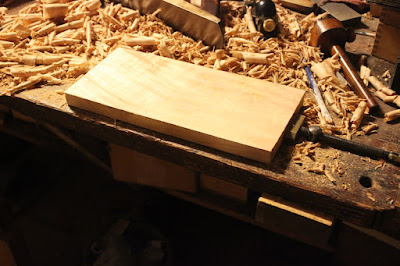A few months ago, one of my very dear clients announced that their daughter was getting married and they asked me to create a keepsake box to present as a wedding gift for the new couple. Having watched the young lady grow up over the last twenty seven years, and given all of the work that I have done for the family over those same years, I was very happy to make something that would be extra spacial for them.
 |
| Centre front detail of the wedding box |
The only stipulation, other than an idea of the size, that I was given was a suggestion that it should somehow include an inscription with the surname on it. Otherwise, I had free artistic license to do anything I liked as the clients said they knew, "whatever you make will be beautiful."
I was informed that both bride and groom like "archeology", but was not given any specific culture or time period, I did know the couple would be going to Crete for their honeymoon, so my initial thought was to make something with a Minoan theme, as I too have an interest in archeology, especially as it relates to ancient advanced civilisations. However, as I began planning what I would make, I realised that I am a "mediaeval guy" and I should stick with what I know and like the best, so I landed on the 12th century and started working on something.
As with all of my furniture and boxes, this had to be completely hand made, (my own stipulation, not the clients') I chose a plank and started sawing. At this point, I had no clear idea what I would be making, yet.
 |
| Sawing by hand. (These pictures are taken from videos) |
 |
| Planing the first face flat |
 |
| marking the edge of the second to produce parallel faces |
 |
| planing the second face |
 |
| "shooting" (squaring up) the ends |
 |
| Ripping the piece of timber into two halves |
 |
| We now have two long sides for the box |
Years ago, I did an intarsia project and had a lot of material left from that; I decided that some of that stuff would be good material to decorate the box with. That part I had decided on, even before I started cutting the timbers, but that was about as far as my planning had gone. I had also decided on the length and width of the inside of the box; the outside dimensions were determined by the timbers that I chose.
It is not well known, and some "histories of furniture" would have you believe very much otherwise, but intarsia work never left the world of furniture ornamentation during the middle ages. It was an art very much practiced by the Romans, and a couple well preserved carbonised examples in Herculaneum prove this to be true. I have seen some old photographs of a now lost (?) 7th century box which was made this way, there are illustrations of the art from 9th century manuscripts, and there is a 10th century multi-leaved wax tablet floating around somewhere, whose outer leaves are thus decorated. This brings us to the 11th and 12 centuries from which there are quite a number of surviving examples of intarsia boxes of German origin
 |
| Video stills showing the making of the centre |
 |
| Cleaning up the intarsia "love knot" inserted into the fig-wood centre |
 |
| The centre intarsia, complete and ready for a border |
Nearly twenty years ago, we had a very harsh winter and some fig trees of the grandfather of the bride were killed by that cold. I took a piece of one of the trunks, when it was cut down, because I wanted to see what fig wood looked like. I cut it up as "oyster veneer" (Meaning veneer cut across the trunk of the tree, not with the grain) and it has been lying around my shop, ever since. The grandfather (now deceased) and granddaughter had a very close relationship, so I thought it a fitting gesture to incorporate some of his tree into her wedding box, thus I chose it to go around the "love knot" intarsia.
Once I had established the idea of the material for the box, the question was how to incorporate an inscription into the mix. Somehow, I came up with the idea of using bone, which one often finds paired with wood in mediaeval boxes. I have done several furniture restorations over the years, using bone to replace missing ivory that had been used in the pieces. I still had a couple bones in a drawer so I got one of those out, and it was of a perfect size to do a plate with their surname on it, and that was where it all started. I then had to make another plate for the initials of the couple, and then a couple more were wanted to complete a frame for the intarsia "love knot", again, something that I had made up years ago.
 |
| Preparing to make some flat plates from bone |
 |
| Cutting the bone (video still) |
 |
| cutting the plate to width |
 |
| Beginning the monogram |
 |
| side pieces to complete the border |
To be continued.
The box is finished and has been delivered, but I wanted to keep this project private until after the fact, no pictures of it went on this blog or my Instagram page until after the wedding, because no one knew what I was doing and I wanted to keep it that way. I will post more pictures and more of the story of its making in future posts

No comments:
Post a Comment